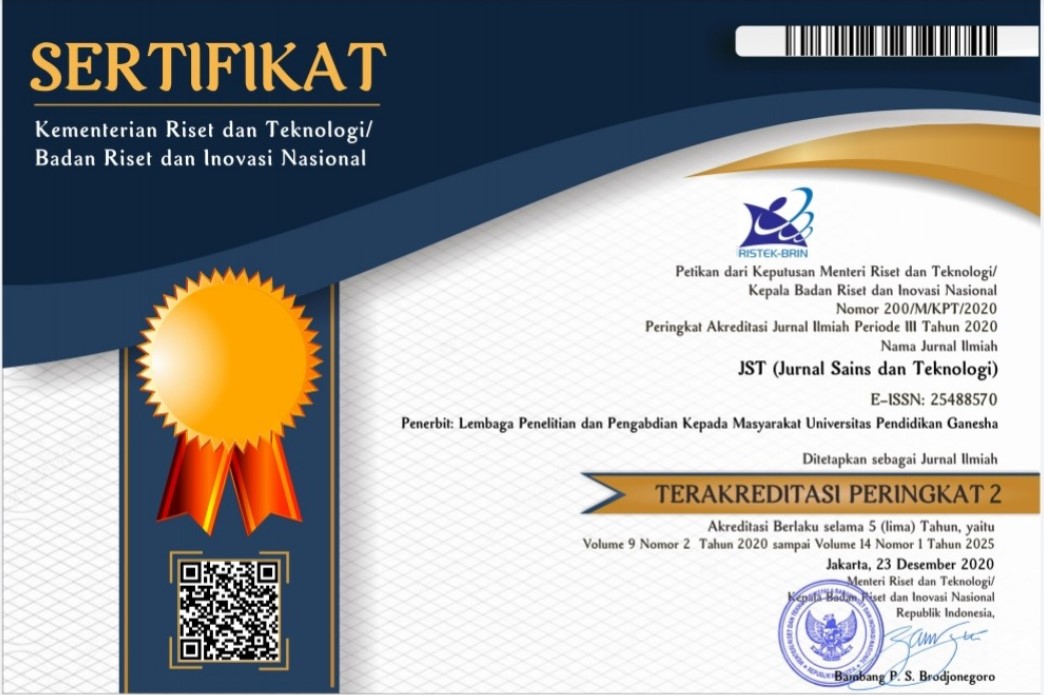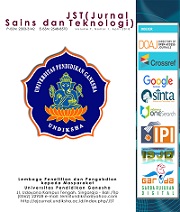Impact of Correlation of Multimedia Elements with Tablets and Digital Stories in Educational Management
DOI:
https://doi.org/10.23887/jstundiksha.v13i2.79123Keywords:
Multimedia, Tablet, Digital Story, Learning, EducationAbstract
Technological media is an effective teaching method among educators because it is easier and faster to implement. However, the use of interaction features and multimedia elements such as text and images in creating storytelling is still problematic for students and teachers. In addition, the assessment element of storytelling with technology still needs to be improved. The purpose of the study was to analyze the Reliability of Multimedia Elements on Tablets and Digital Story Evaluation and to determine the Correlation of Multimedia Elements on Tablets and Digital Story Evaluation. The research method is a quantitative survey approach. Subjects totaled 67 students, students, teachers, and lecturers. Data collection techniques used instruments developed from indicators of multimedia elements, digital stories, and tablets. The instrument was rated based on a Likert scale from point 1 to point 7. Data analysis techniques using SPSS Version 25.0 with validation test, mean, standard deviation, minimum value, and correlation. Results showed that multimedia, digital stories, and tablets had high reliability and correlation and a positive and significant relationship between all variables in the evaluation. This finding confirms that the elements in multimedia are at level 5 and can be used in an effective learning process. The implication provides an overview for teachers and students to use multimedia as a tool for the learning process actively.
References
Abdulrahaman, M. D., Faruk, N., Oloyede, A. A., Surajudeen-Bakinde, N. T., Olawoyin, L. A., Mejabi, O. V., Imam-Fulani, Y. O., Fahm, A. O., & Azeez, A. L. (2020). Multimedia tools in the teaching and learning processes: A systematic review. Heliyon, 6(11), e05312.1-14. https://doi.org/10.1016/j.heliyon.2020.e05312. DOI: https://doi.org/10.1016/j.heliyon.2020.e05312
Alghazi, S. S., Wong, S. Y., Kamsin, A., Yadegaridehkordi, E., & Shuib, L. (2020). Towards sustainable mobile learning: A brief review of the factors influencing acceptance of the use of mobile phones as learning tools. Sustainability (Switzerland), 12(24), 1–19. https://doi.org/10.3390/su122410527. DOI: https://doi.org/10.3390/su122410527
Beykmirza, R., Nikfarid, L., Negarandeh, R., Sarkhani, N., & Moradi Cherati, M. (2022). Development and validation of an instrument to measure pediatric nurses’ adherence to ethical codes. BMC Medical Ethics, 23(1), 1–8. https://doi.org/10.1186/s12910-022-00753-4. DOI: https://doi.org/10.1186/s12910-022-00753-4
Botsis, T., Fairman, J. E., Moran, M. B., & Anagnostou, V. (2020). Visual storytelling enhances knowledge dissemination in biomedical science. Journal of Biomedical Informatics, 107(August 2019), 103458.1-13. https://doi.org/10.1016/j.jbi.2020.103458. DOI: https://doi.org/10.1016/j.jbi.2020.103458
Chevalier, M., Giang, C., El-Hamamsy, L., Bonnet, E., Papaspyros, V., Pellet, J. P., Audrin, C., Romero, M., Baumberger, B., & Mondada, F. (2022). The role of feedback and guidance as intervention methods to foster computational thinking in educational robotics learning activities for primary school. Computers and Education, 180(December 2021), 104431.1-15. https://doi.org/10.1016/j.compedu.2022.104431. DOI: https://doi.org/10.1016/j.compedu.2022.104431
Chvala, L. (2020). Teacher ideologies of English in 21st century Norway and new directions for locally tailored ELT. System, 94(November 2020,), 102327.`-11. https://doi.org/10.1016/j.system.2020.102327. DOI: https://doi.org/10.1016/j.system.2020.102327
Davy Tsz Kit, N. G., Luo, W., Chan, H. M. Y., & Chu, S. K. W. (2022). Using digital story writing as a pedagogy to develop AI literacy among primary students. Computers and Education: Artificial Intelligence, 3(October 2021), 100054.1-14. https://doi.org/10.1016/j.caeai.2022.100054. DOI: https://doi.org/10.1016/j.caeai.2022.100054
De Juan-Roldán, J. I., Castillo-Jimena, M., González-Hevilla, A., Sánchez-Sánchez, C., García-Ruiz, A. J., & Gavilán-Moral, E. (2022). Cross-cultural adaptation and psychometric validation of a Spanish version of the revised Patients’ Attitudes Towards Deprescribing (rPATD) questionnaire. BMJ Open, 12(4), 1-41. https://doi.org/10.1136/bmjopen-2021-050678. DOI: https://doi.org/10.1136/bmjopen-2021-050678
Debnath, R., Darby, S., Bardhan, R., Mohaddes, K., & Sunikka-Blank, M. (2020). Grounded reality meets machine learning: A deep-narrative analysis framework for energy policy research. Energy Research and Social Science, 69(July), 101704.1-14. https://doi.org/10.1016/j.erss.2020.101704. DOI: https://doi.org/10.1016/j.erss.2020.101704
Dubé, A. K., & Wen, R. (2022). Identification and evaluation of technology trends in K-12 education from 2011 to 2021. Education and Information Technologies, 27(2), 1929–1958. https://doi.org/10.1007/s10639-021-10689-8. DOI: https://doi.org/10.1007/s10639-021-10689-8
Ferguson, C., van den Broek, E. L., & van Oostendorp, H. (2020). On the role of interaction mode and story structure in virtual reality serious games. Computers and Education, 143, 1–13. https://doi.org/10.1016/j.compedu.2019.103671. DOI: https://doi.org/10.1016/j.compedu.2019.103671
Gilliam, E. H., Brunner, J. M., Bolan, J., Lee, S., Nuffer, W., Franson, K. L., & Thompson, M. E. (2020). Cultivating a culture of reflection among pharmacy students through storytelling. American Journal of Pharmaceutical Education, 84(4), 489–497. https://doi.org/10.5688/ajpe7633. DOI: https://doi.org/10.5688/ajpe7633
Girón-García, C., & Fortanet-Gómez, I. (2023). Science dissemination videos as multimodal supporting resources for ESP teaching in higher education. English for Specific Purposes, 70(April 2023), 164–176. https://doi.org/10.1016/j.esp.2022.12.005. DOI: https://doi.org/10.1016/j.esp.2022.12.005
Hafeman, D. M., Ostroff, A. N., Feldman, J., Hickey, M. B., Phillips, M. L., Creswell, D., Birmaher, B., & Goldstein, T. R. (2020). Mindfulness-based intervention to decrease mood lability in at-risk youth: Preliminary evidence for changes in resting state functional connectivity. Journal of Affective Disorders, 276(April), 23–29. https://doi.org/10.1016/j.jad.2020.06.042. DOI: https://doi.org/10.1016/j.jad.2020.06.042
Haleem, A., Javaid, M., Qadri, M. A., & Suman, R. (2022). Understanding the role of digital technologies in education: A review. Sustainable Operations and Computers, 3, 275–285. https://doi.org/https://doi.org/10.1016/j.susoc.2022.05.004. DOI: https://doi.org/10.1016/j.susoc.2022.05.004
Hermann, R. R., & Bossle, M. B. (2020). Bringing an entrepreneurial focus to sustainability education: A teaching framework based on content analysis. Journal of Cleaner Production, 246(2), 1–57. https://doi.org/10.1016/j.jclepro.2019.119038. DOI: https://doi.org/10.1016/j.jclepro.2019.119038
Jääskeläinen, I. P., Sams, M., Glerean, E., & Ahveninen, J. (2021). Movies and narratives as naturalistic stimuli in neuroimaging. NeuroImage, 224(October 2020), 1-14. https://doi.org/10.1016/j.neuroimage.2020.117445. DOI: https://doi.org/10.1016/j.neuroimage.2020.117445
Jahnke, I., & Liebscher, J. (2020). Three types of integrated course designs for using mobile technologies to support creativity in higher education. Computers and Education, 146(March 2020), 103782.1-28. https://doi.org/10.1016/j.compedu.2019.103782. DOI: https://doi.org/10.1016/j.compedu.2019.103782
Jalaluddin, I., Ismail, L., & Darmi, R. (2020). Developing vocabulary knowledge among low achievers: Mobile augmented reality (MAR) practicality. International Journal of Information and Education Technology, 10(11), 813–819. https://doi.org/10.18178/ijiet.2020.10.11.1463. DOI: https://doi.org/10.18178/ijiet.2020.10.11.1463
Jensen, W., Craft, B., Löchtefeld, M., & Bjørn, P. (2022). Learning through interactive artifacts: Personal fabrication using electrochromic displays to remember Atari women programmers. Entertainment Computing, 40(February 2021), 1–13. https://doi.org/10.1016/j.entcom.2021.100464. DOI: https://doi.org/10.1016/j.entcom.2021.100464
John, S. P., & De’Villiers, R. (2020). Elaboration of marketing communication through visual media: An empirical analysis. Journal of Retailing and Consumer Services, 54(April 2019), 102052.1-14. https://doi.org/10.1016/j.jretconser.2020.102052. DOI: https://doi.org/10.1016/j.jretconser.2020.102052
Johnson, J. L., Adkins, D., & Chauvin, S. (2020). A review of the quality indicators of rigor in qualitative research. American Journal of Pharmaceutical Education, 84(1), 138–146. https://doi.org/10.5688/ajpe7120. DOI: https://doi.org/10.5688/ajpe7120
Kalantari, S., Rubegni, E., Benton, L., & Vasalou, A. (2023). “When I’m writing a story, I am really good” Exploring the use of digital storytelling technology at home. International Journal of Child-Computer Interaction, 38(July), 100613.1-10. https://doi.org/10.1016/j.ijcci.2023.100613. DOI: https://doi.org/10.1016/j.ijcci.2023.100613
Khosrawi-Rad, B., Grogorick, L., & Robra-Bissantz, S. (2023). Game-inspired Pedagogical Conversational Agents: A Systematic Literature Review. AIS Transactions on Human-Computer Interaction, 15(2), 146–192. https://doi.org/10.17705/1thci.00087. DOI: https://doi.org/10.17705/1thci.00187
Kim, D., Yatsu, D. K., & Li, Y. (2021). A multimodal model for analyzing middle school English language learners’ digital stories. International Journal of Educational Research Open, 2(August), 100067.1-9. https://doi.org/10.1016/j.ijedro.2021.100067. DOI: https://doi.org/10.1016/j.ijedro.2021.100067
Klima Ronen, I. (2020). Action research as a methodology for professional development in leading an educational process. Studies in Educational Evaluation, 64(June 2019), 100826.1-9. https://doi.org/10.1016/j.stueduc.2019.100826. DOI: https://doi.org/10.1016/j.stueduc.2019.100826
Latini, N., Bråten, I., & Salmerón, L. (2020). Does reading medium affect processing and integration of textual and pictorial information? A multimedia eye-tracking study. Contemporary Educational Psychology, 62(April), 101870.1-13. https://doi.org/10.1016/j.cedpsych.2020.101870. DOI: https://doi.org/10.1016/j.cedpsych.2020.101870
Li, M. (2020). Multimodal pedagogy in TESOL teacher education: Students’ perspectives. System, 94(November 2020), 102337.1-13. https://doi.org/10.1016/j.system.2020.102337. DOI: https://doi.org/10.1016/j.system.2020.102337
Lowery, B., Dagevos, J., Chuenpagdee, R., & Vodden, K. (2020). Storytelling for sustainable development in rural communities: An alternative approach. Sustainable Development, 28(6), 1813–1826. https://doi.org/10.1002/sd.2124. DOI: https://doi.org/10.1002/sd.2124
Mascini, A., Cnudde, V., & Bultreys, T. (2020). Event-based contact angle measurements inside porous media using time-resolved micro-computed tomography. Journal of Colloid and Interface Science, 572(2), 354–363. https://doi.org/10.1016/j.jcis.2020.03.099. DOI: https://doi.org/10.1016/j.jcis.2020.03.099
Miranda, J., Navarrete, C., Noguez, J., Molina-Espinosa, J. M., Ramírez-Montoya, M. S., Navarro-Tuch, S. A., Bustamante-Bello, M. R., Rosas-Fernández, J. B., & Molina, A. (2021). The core components of education 4.0 in higher education: Three case studies in engineering education. Computers and Electrical Engineering, 93(February), 1-13. https://doi.org/10.1016/j.compeleceng.2021.107278. DOI: https://doi.org/10.1016/j.compeleceng.2021.107278
Mishra, L., Gupta, T., & Shree, A. (2020). Online teaching-learning in higher education during lockdown period of COVID-19 pandemic. International Journal of Educational Research Open, 1(September), 100012.1-8. https://doi.org/10.1016/j.ijedro.2020.100012. DOI: https://doi.org/10.1016/j.ijedro.2020.100012
Mohammad, A., & Pedersen, L. (2022). Analyzing the Use of Heuristics in a Virtual Reality Learning Context: A Literature Review. Informatics, 9(3), 1-9. https://doi.org/10.3390/informatics9030051. DOI: https://doi.org/10.3390/informatics9030051
Mohtar, S., Jomhari, N., Mustafa, M. B., & Yusoff, Z. M. (2023). Mobile learning: research context, methodologies and future works towards middle-aged adults – a systematic literature review. Multimedia Tools and Applications, 82(7), 11117–11143. https://doi.org/10.1007/s11042-022-13698-y. DOI: https://doi.org/10.1007/s11042-022-13698-y
Muhanna, M. A., Amro, R. N., & Qusef, A. (2020). Using a new set of heuristics in evaluating Arabic interfaces. Journal of King Saud University - Computer and Information Sciences, 32(2), 248–253. https://doi.org/10.1016/j.jksuci.2018.05.014. DOI: https://doi.org/10.1016/j.jksuci.2018.05.014
Nair, V., & Yunus, M. M. (2021). A systematic review of digital storytelling in improving speaking skills. Sustainability (Switzerland), 13(17), 1–17. https://doi.org/10.3390/su13179829. DOI: https://doi.org/10.3390/su13179829
Naqvi, A. A., Mahmoud, M. A., AlShayban, D. M., Alharbi, F. A., Alolayan, S. O., Althagfan, S., Iqbal, M. S., Farooqui, M., Ishaqui, A. A., Elrggal, M. E., Haseeb, A., & Hassali, M. A. (2020). Translation and validation of the Arabic version of the General Medication Adherence Scale (GMAS) in Saudi patients with chronic illnesses. Saudi Pharmaceutical Journal, 28(9), 1055–1061. https://doi.org/10.1016/j.jsps.2020.07.005. DOI: https://doi.org/10.1016/j.jsps.2020.07.005
Neuman, S. B., Samudra, P., & Wong, K. M. (2021). Two may be better than one: Promoting incidental word learning through multiple media. Journal of Applied Developmental Psychology, 73(February), 101252.1-8. https://doi.org/10.1016/j.appdev.2021.101252. DOI: https://doi.org/10.1016/j.appdev.2021.101252
Rangraz Jeddi, F., Nabovati, E., Bigham, R., & Farrahi, R. (2020). Usability evaluation of a comprehensive national health information system: A heuristic evaluation. Informatics in Medicine Unlocked, 19(2), 100332.1-9. https://doi.org/10.1016/j.imu.2020.100332. DOI: https://doi.org/10.1016/j.imu.2020.100332
Rodríguez, C. L., García-Jiménez, M., Massó-Guijarro, B., & Cruz-González, C. (2021). Digital Storytelling in Education: A Systematic Review of the Literature. Review of European Studies, 13(2), 1-13. https://doi.org/10.5539/res.v13n2p13. DOI: https://doi.org/10.5539/res.v13n2p13
Rubegni, E., Landoni, M., Malinverni, L., & Jaccheri, L. (2022). Raising Awareness of Stereotyping Through Collaborative Digital Storytelling: Design for Change with and for Children. International Journal of Human Computer Studies, 157(October), 1-27. https://doi.org/10.1016/j.ijhcs.2021.102727. DOI: https://doi.org/10.1016/j.ijhcs.2021.102727
Sailer, M., Schultz-pernice, F., & Fischer, F. (2021). Computers in Human Behavior Contextual facilitators for learning activities involving technology in higher education : The C ♭ -model. Computers in Human Behavior, 121(March), 106794. 1-13. https://doi.org/10.1016/j.chb.2021.106794. DOI: https://doi.org/10.1016/j.chb.2021.106794
Salminen, J., Jung, S. gyo, Nielsen, L., Şengün, S., & Jansen, B. J. (2022). How does varying the number of personas affect user perceptions and behavior? Challenging the ‘small personas’ hypothesis! International Journal of Human Computer Studies, 168(August 2022), 1-17. https://doi.org/10.1016/j.ijhcs.2022.102915. DOI: https://doi.org/10.1016/j.ijhcs.2022.102915
Sánchez-Velasco, L. E., Arias-Montiel, M., Guzmán-Ramírez, E., & Lugo-González, E. (2020). A Low-Cost EMG-Controlled Anthropomorphic Robotic Hand for Power and Precision Grasp. Biocybernetics and Biomedical Engineering, 40(1), 221–237. https://doi.org/10.1016/j.bbe.2019.10.002. DOI: https://doi.org/10.1016/j.bbe.2019.10.002
Shinas, V. H., & Wen, H. (2022). Preparing teacher candidates to implement digital storytelling. Computers and Education Open, 3(June 2021), .1-8. https://doi.org/10.1016/j.caeo.2022.100079. DOI: https://doi.org/10.1016/j.caeo.2022.100079
Silvia, R. J. (2020). The arts in health professions education: A music assignment to develop pharmacy students’ empathy toward people with opioid use disorder. American Journal of Pharmaceutical Education, 84(4), 484–488. https://doi.org/10.5688/ajpe7631. DOI: https://doi.org/10.5688/ajpe7631
Sobrino-Duque, R., Martínez-Rojo, N., Carrillo-de-Gea, J. M., López-Jiménez, J. J., Nicolás, J., & Fernández-Alemán, J. L. (2022). Evaluating a gamification proposal for learning usability heuristics: Heureka. International Journal of Human Computer Studies, 161(April 2021), 1-15. https://doi.org/10.1016/j.ijhcs.2022.102774. DOI: https://doi.org/10.1016/j.ijhcs.2022.102774
Suryaman, M., Cahyono, Y., Muliansyah, D., Bustani, O., Suryani, P., Fahlevi, M., Pramono, R., Purwanto, A., Purba, J. T., Munthe, A. P., Juliana, & Harimurti, S. M. (2020). COVID-19 pandemic and home online learning system: Does it affect the quality of pharmacy school learning? Systematic Reviews in Pharmacy, 11(8), 524–530. https://doi.org/10.31838/srp.2020.8.74.
Taghizadeh, G., Martinez-Martin, P., Meimandi, M., Habibi, S. A. H., Jamali, S., Dehmiyani, A., Rostami, S., Mahmuodi, A., Mehdizadeh, M., & Fereshtehnejad, S. M. (2020). Barthel Index and modified Rankin Scale: Psychometric properties during medication phases in idiopathic Parkinson disease. Annals of Physical and Rehabilitation Medicine, 63(6), 500–504. https://doi.org/10.1016/j.rehab.2019.08.006. DOI: https://doi.org/10.1016/j.rehab.2019.08.006
Talan, T. (2021). Dijital Öyküleme Yönteminin Meta-Analitik ve Meta-Tematik Analizi. Bartın University Journal of Faculty of Education, 10(1), 18–38. https://doi.org/10.14686/buefad.706231. DOI: https://doi.org/10.14686/buefad.706231
Tavares, N. (2022). The use and impact of game-based learning on the learning experience and knowledge retention of nursing undergraduate students: A systematic literature review. Nurse education today, 117(March), 105484.1-6. https://doi.org/10.1016/j.nedt.2022.105484. DOI: https://doi.org/10.1016/j.nedt.2022.105484
Tohiran, K. A., Nobilly, F., Zulkifli, R., Yahya, M. S., Norhisham, A. R., Rasyidi, M. Z., & Azhar, B. (2023). Multi-species rotational grazing of small ruminants regenerates undergrowth vegetation while controlling weeds in the oil palm silvopastoral system. Agricultural Systems, 210(September), 103720.1-12. https://doi.org/10.1016/j.agsy.2023.103720. DOI: https://doi.org/10.1016/j.agsy.2023.103720
Tuma, F. (2021). The use of educational technology for interactive teaching in lectures. Annals of Medicine and Surgery, 62(December 2020), 231–235. https://doi.org/10.1016/j.amsu.2021.01.051. DOI: https://doi.org/10.1016/j.amsu.2021.01.051
Vackova, P., Cermakova, A. L., & Kucirkova, N. I. (2023). Children’s Digital Books: Development, Testing and Dissemination of Quality Criteria. In Children’s Digital Books: Development, Testing and Dissemination of Quality Criteria (Nomor August). https://doi.org/10.31265/usps.268. DOI: https://doi.org/10.31265/USPS.268
Xu, K. (2020). Language, modality, and mobile media use experiences: Social responses to smartphone cues in a task-oriented context. Telematics and Informatics, 48(June 2019), 101344.1-13. https://doi.org/10.1016/j.tele.2020.101344. DOI: https://doi.org/10.1016/j.tele.2020.101344
Zhang, X., Tan, S. S., Bilajac, L., Alhambra-Borrás, T., Garcés-Ferrer, J., Verma, A., Koppelaar, E., Markaki, A., Mattace-Raso, F., Franse, C. B., & Raat, H. (2020). Reliability and Validity of the Tilburg Frailty Indicator in 5 European Countries. Journal of the American Medical Directors Association, 21(6), 772-779.e6. https://doi.org/10.1016/j.jamda.2020.03.019. DOI: https://doi.org/10.1016/j.jamda.2020.03.019
Downloads
Published
How to Cite
Issue
Section
License
Copyright (c) 2024 Rabiyatul Rabiyatul Jasiyah

This work is licensed under a Creative Commons Attribution-ShareAlike 4.0 International License.
Authors who publish with the Jurnal Sains dan Teknologi (JST) agree to the following terms:
- Authors retain copyright and grant the journal the right of first publication with the work simultaneously licensed under a Creative Commons Attribution License (CC BY-SA 4.0) that allows others to share the work with an acknowledgment of the work's authorship and initial publication in this journal.
- Authors are able to enter into separate, additional contractual arrangements for the non-exclusive distribution of the journal's published version of the work (e.g., post it to an institutional repository or publish it in a book), with an acknowledgment of its initial publication in this journal.
- Authors are permitted and encouraged to post their work online (e.g., in institutional repositories or on their website) prior to and during the submission process, as it can lead to productive exchanges, as well as earlier and greater citation of published work. (See The Effect of Open Access)















